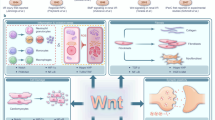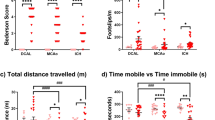Abstract
Recent findings have provided insights into pathogenic mechanism(s) that may complement and add to the traditional glutamatergic mechanisms to which ischemic brain injury is ascribed. The discovery of mechanisms leading to ionic imbalance and signaling cascades that mediate cross-talk between redundant pathways of cell death, as well as mechanisms that operate downstream of, upstream of and in parallel with excitotoxicity, has spurred new research into therapeutics ranging from proof of concept in animals to human clinical trials. This Perspective presents an integrated consideration of new molecular pathogenic mechanisms underlying ischemic damage in the brain, and how our combined knowledge of these mechanisms and our existing knowledge of excitotoxicity may establish new targets for therapy, by allowing clearer boundaries on what might be expected of a given intervention, and may yield advances that will benefit patients.
This is a preview of subscription content, access via your institution
Access options
Subscribe to this journal
Receive 12 print issues and online access
$209.00 per year
only $17.42 per issue
Buy this article
- Purchase on Springer Link
- Instant access to full article PDF
Prices may be subject to local taxes which are calculated during checkout


Similar content being viewed by others
References
Guo, S. & Lo, E.H. Dysfunctional cell-cell signaling in the neurovascular unit as a paradigm for central nervous system disease. Stroke 40, S4–S7 (2009).
Lau, A. & Tymianski, M. Glutamate receptors, neurotoxicity and neurodegeneration. Pflugers Arch. 460, 525–542 (2010).
Lipton, P. Ischemic cell death in brain neurons. Physiol. Rev. 79, 1431–1568 (1999).
McShane, R., Areosa Sastre, A. & Minakaran, N. Memantine for dementia. Cochrane Database Syst. Rev. 19, CD003154 (2006).
Hardingham, G.E. & Bading, H. Synaptic versus extrasynaptic NMDA receptor signalling: implications for neurodegenerative disorders. Nat. Rev. Neurosci. 11, 682–696 (2010).
Petralia, R.S. et al. Organization of NMDA receptors at extrasynaptic locations. Neuroscience 167, 68–87 (2010).
Hardingham, G.E. Pro-survival signalling from the NMDA receptor. Biochem. Soc. Trans. 34, 936–938 (2006).
Zhang, S.J. et al. Nuclear calcium signaling controls expression of a large gene pool: identification of a gene program for acquired neuroprotection induced by synaptic activity. PLoS Genet. 5, e1000604 (2009).
Hardingham, G.E., Fukunaga, Y. & Bading, H. Extrasynaptic NMDARs oppose synaptic NMDARs by triggering CREB shut-off and cell death pathways. Nat. Neurosci. 5, 405–414 (2002).
Ivanov, A. et al. Opposing role of synaptic and extrasynaptic NMDA receptors in regulation of the extracellular signal-regulated kinases (ERK) activity in cultured rat hippocampal neurons. J. Physiol. (Lond.) 572, 789–798 (2006).
Xia, P., Chen, H.S., Zhang, D. & Lipton, S.A. Memantine preferentially blocks extrasynaptic over synaptic NMDA receptor currents in hippocampal autapses. J. Neurosci. 30, 11246–11250 (2010).
Liu, Y. et al. NMDA receptor subunits have differential roles in mediating excitotoxic neuronal death both in vitro and in vivo. J. Neurosci. 27, 2846–2857 (2007).
Husi, H., Ward, M.A., Choudhary, J.S., Blackstock, W.P. & Grant, S.G. Proteomic analysis of NMDA receptor-adhesion protein signaling complexes. Nat. Neurosci. 3, 661–669 (2000).
Kornau, H.C., Schenker, L.T., Kennedy, M.B. & Seeburg, P.H. Domain interaction between NMDA receptor subunits and the postsynaptic density protein PSD-95. Science 269, 1737–1740 (1995).
Sheng, M. & Pak, D.T. Glutamate receptor anchoring proteins and the molecular organization of excitatory synapses. Ann. N.Y. Acad. Sci. 868, 483–493 (1999).
Christopherson, K.S., Hillier, B.J., Lim, W.A. & Bredt, D.S. PSD-95 assembles a ternary complex with the N-methyl-D-aspartic acid receptor and a bivalent neuronal NO synthase PDZ domain. J. Biol. Chem. 274, 27467–27473 (1999).
Sattler, R. et al. Specific coupling of NMDA receptor activation to nitric oxide neurotoxicity by PSD-95 protein. Science 284, 1845–1848 (1999).
Aarts, M. et al. Treatment of ischemic brain damage by perturbing NMDA receptor- PSD-95 protein interactions. Science 298, 846–850 (2002).
Soriano, F.X. et al. Specific targeting of pro-death NMDA receptor signals with differing reliance on the NR2B PDZ ligand. J. Neurosci. 28, 10696–10710 (2008).
Tu, W. et al. DAPK1 interaction with NMDA receptor NR2B subunits mediates brain damage in stroke. Cell 140, 222–234 (2010).
Ning, K. et al. Dual neuroprotective signaling mediated by downregulating two distinct phosphatase activities of PTEN. J. Neurosci. 24, 4052–4060 (2004).
Besancon, E., Guo, S., Lok, J., Tymianski, M. & Lo, E.H. Beyond NMDA and AMPA glutamate receptors: emerging mechanisms for ionic imbalance and cell death in stroke. Trends Pharmacol. Sci. 29, 268–275 (2008).
Venkatachalam, K. & Montell, C. TRP channels. Annu. Rev. Biochem. 76, 387–417 (2007).
Hara, Y. et al. LTRPC2 Ca2+-permeable channel activated by changes in redox status confers susceptibility to cell death. Mol. Cell 9, 163–173 (2002).
Kaneko, S. et al. A critical role of TRPM2 in neuronal cell death by hydrogen peroxide. J. Pharmacol. Sci. 101, 66–76 (2006).
Aarts, M. et al. A key role for TRPM7 channels in anoxic neuronal death. Cell 115, 863–877 (2003).
McNulty, S. & Fonfria, E. The role of TRPM channels in cell death. Pflugers Arch. 451, 235–242 (2005).
Xie, Y.F., Macdonald, J.F. & Jackson, M.F. TRPM2, calcium and neurodegenerative diseases. Int. J. Physiol. Pathophysiol. Pharmacol. 2, 95–103 (2010).
MacDonald, J.F., Xiong, Z.G. & Jackson, M.F. Paradox of Ca2+ signaling, cell death and stroke. Trends Neurosci. 29, 75–81 (2006).
Perraud, A.L. et al. ADP-ribose gating of the calcium-permeable LTRPC2 channel revealed by Nudix motif homology. Nature 411, 595–599 (2001).
Fonfria, E. et al. TRPM2 is elevated in the tMCAO stroke model, transcriptionally regulated, and functionally expressed in C13 microglia. J. Recept. Signal Transduct. Res. 26, 179–198 (2006).
Olah, M.E. et al. Ca2+-dependent induction of TRPM2 currents in hippocampal neurons. J. Physiol. (Lond.) 587, 965–979 (2009).
Jia, J. et al. Sex differences in neuroprotection provided by inhibition of TRPM2 channels following experimental stroke. J. Cereb. Blood Flow Metab. published online, doi:10.1038/jcbfm.2011.77 (18 May 2011).
Nadler, M.J. et al. LTRPC7 is a Mg.ATP-regulated divalent cation channel required for cell viability. Nature 411, 590–595 (2001).
Wei, W.L. et al. TRPM7 channels in hippocampal neurons detect levels of extracellular divalent cations. Proc. Natl. Acad. Sci. USA 104, 16323–16328 (2007).
Silver, I.A. & Erecinska, M. Intracellular and extracellular changes of [Ca2+] in hypoxia and ischemia in rat brain in vivo. J. Gen. Physiol. 95, 837–866 (1990).
Yamamoto, S. et al. TRPM2-mediated Ca2+ influx induces chemokine production in monocytes that aggravates inflammatory neutrophil infiltration. Nat. Med. 14, 738–747 (2008).
Jin, J. et al. Deletion of Trpm7 disrupts embryonic development and thymopoiesis without altering Mg2+ homeostasis. Science 322, 756–760 (2008).
Giffard, R.G., Monyer, H., Christine, C.W. & Choi, D.W. Acidosis reduces NMDA receptor activation, glutamate neurotoxicity, and oxygen-glucose deprivation neuronal injury in cortical cultures. Brain Res. 506, 339–342 (1990).
Krishtal, O. The ASICs: signaling molecules? Modulators? Trends Neurosci. 26, 477–483 (2003).
Askwith, C.C., Wemmie, J.A., Price, M.P., Rokhlina, T. & Welsh, M.J. Acid-sensing ion channel 2 (ASIC2) modulates ASIC1 H+-activated currents in hippocampal neurons. J. Biol. Chem. 279, 18296–18305 (2004).
Allen, N.J. & Attwell, D. Modulation of ASIC channels in rat cerebellar Purkinje neurons by ischaemia-related signals. J. Physiol. (Lond.) 543, 521–529 (2002).
Immke, D.C. & McCleskey, E.W. Lactate enhances the acid-sensing Na+ channel on ischemia-sensing neurons. Nat. Neurosci. 4, 869–870 (2001).
Yermolaieva, O., Leonard, A.S., Schnizler, M.K., Abboud, F.M. & Welsh, M.J. Extracellular acidosis increases neuronal cell calcium by activating acid-sensing ion channel 1a. Proc. Natl. Acad. Sci. USA 101, 6752–6757 (2004).
Xiong, Z.G. et al. Neuroprotection in ischemia: blocking calcium-permeable acid-sensing ion channels. Cell 118, 687–698 (2004).
Yen, M.R. & Saier, M.H. Jr. Gap junctional proteins of animals: the innexin/pannexin superfamily. Prog. Biophys. Mol. Biol. 94, 5–14 (2007).
MacVicar, B.A. & Thompson, R.J. Non-junction functions of pannexin-1 channels. Trends Neurosci. 33, 93–102 (2010).
Thompson, R.J., Zhou, N. & MacVicar, B.A. Ischemia opens neuronal gap junction hemichannels. Science 312, 924–927 (2006).
Contreras, J.E. et al. Role of connexin-based gap junction channels and hemichannels in ischemia-induced cell death in nervous tissue. Brain Res. Brain Res. Rev. 47, 290–303 (2004).
Andrade-Rozental, A.F. et al. Gap junctions: the “kiss of death” and the “kiss of life”. Brain Res. Brain Res. Rev. 32, 308–315 (2000).
Author information
Authors and Affiliations
Corresponding author
Ethics declarations
Competing interests
M.T. is president and chief executive officer of NoNO Inc., a biotechnology company dedicated to the translation of new therapies discovered in the author's and collaborators' academic laboratories to human clinical trials.
Rights and permissions
About this article
Cite this article
Tymianski, M. Emerging mechanisms of disrupted cellular signaling in brain ischemia. Nat Neurosci 14, 1369–1373 (2011). https://doi.org/10.1038/nn.2951
Published:
Issue Date:
DOI: https://doi.org/10.1038/nn.2951
This article is cited by
-
GluN2B subunit selective N-methyl-D-aspartate receptor ligands: Democratizing recent progress to assist the development of novel neurotherapeutics
Molecular Diversity (2023)
-
Macamide B Pretreatment Attenuates Neonatal Hypoxic-Ischemic Brain Damage of Mice Induced Apoptosis and Regulates Autophagy via the PI3K/AKT Signaling Pathway
Molecular Neurobiology (2022)
-
miR-383-5p Regulated by the Transcription Factor CTCF Affects Neuronal Impairment in Cerebral Ischemia by Mediating Deacetylase HDAC9 Activity
Molecular Neurobiology (2022)
-
Perillaldehyde improves cognitive function in vivo and in vitro by inhibiting neuronal damage via blocking TRPM2/NMDAR pathway
Chinese Medicine (2021)
-
eNOS-dependent S-nitrosylation of the NF-κB subunit p65 has neuroprotective effects
Cell Death & Disease (2021)



